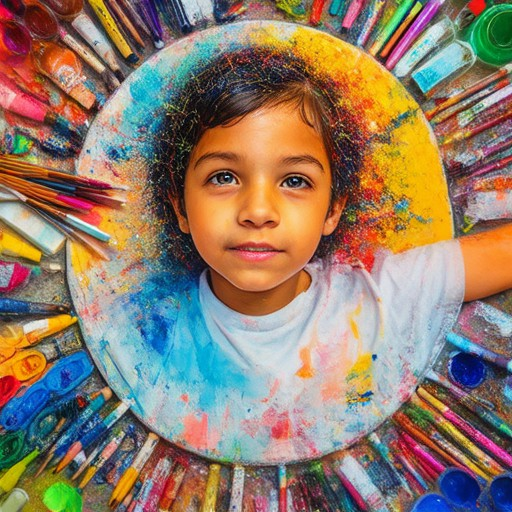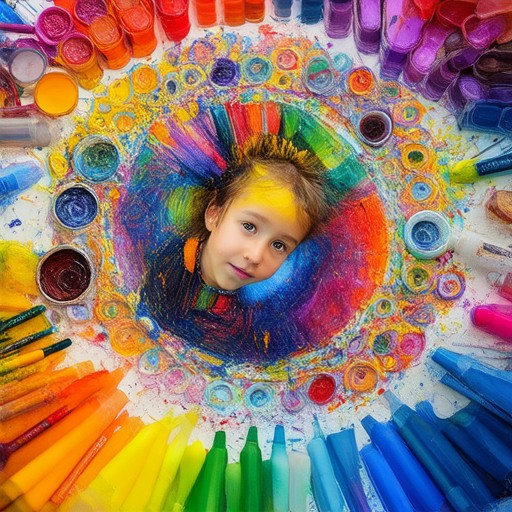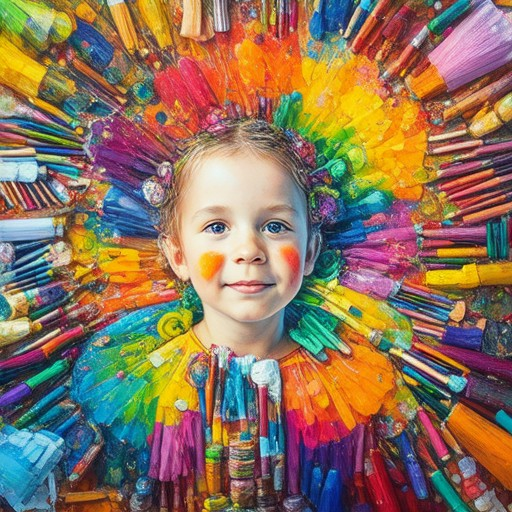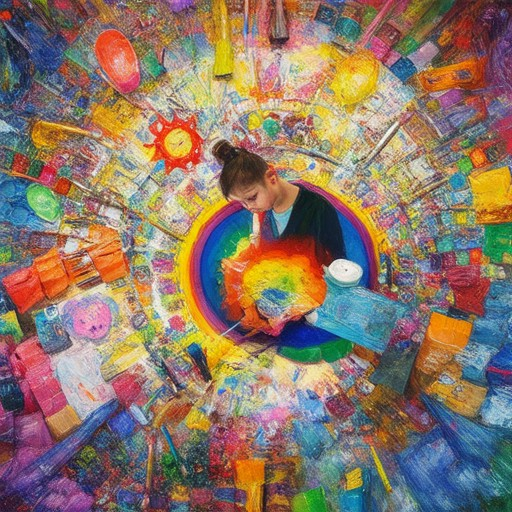Discover the vibrant world of art projects designed specifically for young artists aged 7 and above. Whether you’re looking for creative ways to spark curiosity or inspire future artists, this guide offers a wealth of ideas that are both fun and educational. From exploring trendy art styles and tools to discovering easy-to-follow tutorials, these art projects for kids are perfect for fostering creativity at home. Learn how to keep your little artists engaged with cool art ideas, challenging projects, and practical tips on turning your creations into something truly special. This comprehensive resource covers everything from simple art activities for 8-year-olds to more complex projects for older kids, ensuring there’s something for every age group to enjoy. Dive in and unlock the potential of young artists with this ultimate guide to art projects that inspire and educate.

What is Hot in Art Right Now?
The art world is thriving with fresh trends and innovations that reflect contemporary societal values and technological advancements. Here’s a breakdown of what’s currently popular:
- Personalized and Emotional Art : Artists are focusing on creating works that resonate deeply with individual experiences and values. This trend emphasizes emotional connection and introspection, making art more relatable and meaningful.
- Abstract Expressionism : Bold, vibrant, and emotionally charged paintings are gaining momentum. This style aligns with the growing interest in mental health awareness and personal growth.
- Biophilic Design : Natural elements and organic motifs are being integrated into art, reflecting a broader wellness movement. This trend promotes calmness and mindfulness in the viewer.
- Street Art and Murals : Public art is flourishing, with artists using vibrant colors and thought-provoking themes to transform urban spaces. This genre is increasingly being showcased in galleries.
- Digital Art and NFTs : The rise of digital art and non-fungible tokens (NFTs) has opened new avenues for artists to create and monetize their work. Digital art allows for experimentation and global reach.
- Sustainable Art Practices : Eco-conscious materials and ethical production methods are becoming priorities. Artists are innovating to reduce environmental impact while creating beautiful pieces.
- Feminist Art : This movement is gaining traction, highlighting gender equality and empowering female voices. It challenges traditional norms and fosters social change through art.
- Collectible Art : Smaller, affordable works are growing in popularity, particularly among younger collectors. Platforms like Instagram are democratizing access to art.
- Interactive and Participatory Art : Installations that invite physical engagement are becoming more common. These works encourage community interaction and break down barriers between artist and viewer.
These trends collectively create a vibrant, inclusive, and evolving art scene that caters to a diverse range of tastes and purposes. Whether you’re exploring digital masterpieces, street art, or sustainable creations, there’s something captivating happening in the world of art today.
How to Get an Idea for an Art Project
To come up with an idea for an art project, start by exploring your personal interests and passions. Consider subjects that excite you or topics you’re curious about. Here’s a step-by-step guide to help you find inspiration:
- Explore Personal Interests:** Look at objects, places, or themes that interest you. Spend time observing the world around you, whether it’s through nature, people, or everyday items.
- Seek Inspiration:** Visit museums, galleries, or art shows to see how other artists approach their work. Websites like Artful Journey offer valuable resources and artist stories.
- Experiment with Materials:** Try different art mediums, such as painting, drawing, or mixed media, to see which one resonates with you.
- Reflect on Emotions:** Think about personal experiences or emotions that could translate into a meaningful artwork. Reflect on moments that have impacted you deeply.
- Be Open to Serendipity:** Inspiration can strike from unexpected sources, like a conversation, a song, or even a simple object you encounter.
By combining these approaches, you’ll likely uncover a unique concept for your art project. Remember, the goal is to create something authentic and meaningful that reflects your individual style and perspective.

What to Do When Bored as an Artist
Feeling uninspired as an artist can happen to anyone, but it’s essential to embrace the opportunity to explore new creative avenues. Here are some practical steps to overcome boredom and reignite your artistic passion:
- Experiment with New Techniques : Try something completely different from your usual style. Whether it’s watercolor painting, sculpting, or digital art, experimenting allows you to discover fresh perspectives.
- Participate in Creative Challenges : Join online art challenges or competitions to push your boundaries and connect with fellow artists. Websites like ArtStation often host exciting opportunities.
- Explore Different Art Forms : Step out of your comfort zone and delve into mediums you’ve never tried before, such as pottery, calligraphy, or even street art.
- Research and Inspire Yourself : Look at works from artists you admire on platforms like DeviantArt or Behance . Their creativity can spark new ideas and reignite your motivation.
- Create a Personal Project : Start a personal art project that doesn’t necessarily aim for publication. This freedom can help you explore themes or styles you’ve been curious about.
- Take a Break and Reflect : Sometimes stepping away from your work can provide clarity. Return to it with a fresh perspective later in the day or the next morning.
- Join a Community : Engage with other artists by joining forums or groups on Artful Journey . Sharing ideas and experiences can offer new insights and motivation.
Remember, the most important thing is to stay curious and keep creating. Even small steps can lead to meaningful progress. Happy creating!

What Can I Turn My Art Into?
Your art has endless possibilities for transformation into various products and formats. Here are some creative ways to bring your artwork to life:
- Stickers : Transform your art into vibrant, reusable stickers perfect for personalizing gadgets, backpacks, and more. These are a popular choice due to their versatility and ease of application.
- Clothing : Design eye-catching t-shirts, hoodies, and hats. Collaborate with printing companies to produce high-quality apparel that showcases your unique style.
- Posters and Wall Art : Create large-scale prints or canvas art that can be hung in homes and public spaces. Utilize online printing platforms for production and distribution.
- Books : Compile your sketches or comics into a published book. This requires organizing your work and adding captions or stories to enhance the narrative.
- Mugs and Phone Cases : Personalize mugs and phone cases with your designs. These small items are cost-effective to produce and can be sold at various price points.
- Digital Products : Offer printable downloads that fans can purchase and print themselves. This expands your reach without the need for physical inventory.
- Commissions : Create custom artwork for clients based on their ideas. This allows you to engage with unique projects while building a diverse portfolio.
- Art Prints : Sell high-quality prints of your work. Partner with reputable printing services to ensure your art is displayed in its best form.
Selling your art involves strategic choices about product type, production costs, and marketing efforts. Consider starting with manageable options like stickers or mugs to build your brand presence before exploring more complex projects like clothing or books. Effective promotion through social media and local events can significantly boost sales and visibility.
What Types of Art Sell the Most?
Art comes in various forms, each with its unique appeal and market demand. Understanding which types of art tend to sell more can help artists align their creativity with what the market seeks. Here are some of the most popular and profitable art forms:
- Traditional Landscapes : Scenes of nature, such as mountains, forests, or seascapes, consistently attract buyers. These artworks often evoke a sense of calm and familiarity.
- Abstract Art : Known for its non-representational styles, abstract art appeals to collectors who appreciate innovation and uniqueness. It can command high prices depending on the artist’s reputation.
- Portraiture : Paintings or sculptures of people, whether realistic or stylized, are highly sought after. Celebrity portraits, in particular, can fetch significant sums.
- Still Life : Depictions of inanimate objects, such as flowers, fruits, or everyday items, are popular due to their ability to convey mood and texture.
- Street Art-Inspired Pieces : Urban or street art influences have become mainstream, with many galleries showcasing murals and graffiti-inspired works.
- Pop Art : Combining elements of pop culture, such as comic book characters or iconic figures, this genre is vibrant and appeals to a broad audience.
- Minimalist Art : Known for simplicity and clean lines, minimalist pieces often resonate with modern interiors and can be sold at premium prices.
To enhance your chances of selling art, consider the following tips:
- Know Your Audience : Tailor your artwork to the preferences of your target market, whether it’s corporate executives, students, or families.
- Experiment with Mediums : Explore different materials like oil, acrylic, watercolor, or digital media to find what works best for your style.
- Study Trends : Keep an eye on emerging art trends to stay ahead of the curve and meet current demands.
- Build a Strong Online Presence : Use social media platforms and online galleries to showcase your work and connect with potential buyers globally.
For more insights into maximizing your art sales, explore our Art Sales Tips and discover how to create art that stands out in today’s competitive market.

Is Copying Art Legal?
Copying art is generally considered illegal unless explicit permission is granted by the original creator. Here’s a breakdown of the key points to understand why copying art without proper authorization is not advisable:
1. Copyright Law Basics
Artistic works are protected under copyright law, which grants creators exclusive rights over their creations. This includes paintings, photographs, sculptures, digital art, and other forms of creative expression. Copying these works without permission can lead to legal consequences, including lawsuits and fines.
2. Types of Copyrighted Art
The scope of copyrighted art extends to various forms: – Paintings and fine art – Photographs and images – Sculptures and three-dimensional artwork – Digital art, graphics, and designs – Literary works, including poetry and illustrations
3. Public Domain and Fair Use
While some artworks may fall into the public domain, copying them still requires permission. The public domain refers to works that are not protected by copyright, but this is rare and typically applies to very old pieces. Even then, commercial use often requires licensing. Fair use allows limited use for purposes like education or criticism, but this must be done with proper attribution and not for commercial gain.
4. Consequences of Copying
- Legal Actions: The original creator or their estate can sue for copyright infringement, leading to hefty fines and legal fees.
- Reputation Damage: Being accused of plagiarism can harm your personal and professional reputation.
- Economic Loss: The financial impact of legal battles and settlements can be significant.
5. Best Practices
To respect intellectual property and avoid legal issues: – Always seek permission before using others’ artwork. – Use royalty-free or licensed art when possible. – Support artists by purchasing original works or commissioning custom pieces.
By adhering to these guidelines, you contribute to a healthier creative environment and protect yourself legally.
Learn more about copyright laws and their implications for artists .




0 Comments